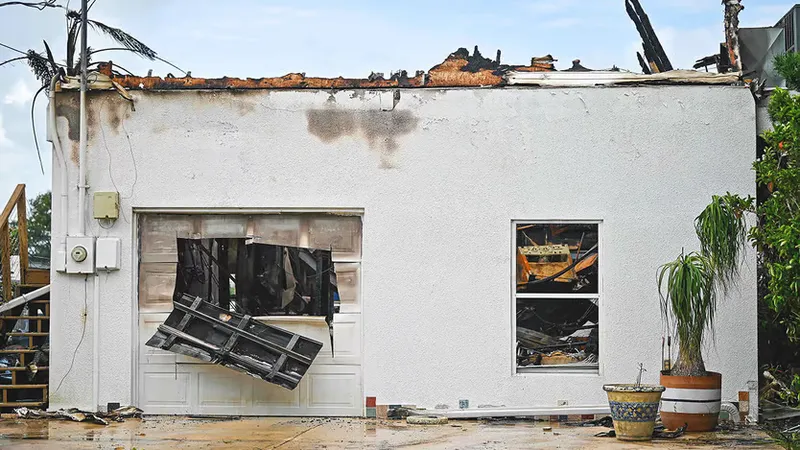Parts of America are becoming uninsurable

Ellie Laks vividly recalls the terrifying sight of a wildfire advancing over the parched hills near her property. As the flames approached, fear gripped her. Laks is the owner of the Gentle Barn, an animal sanctuary nestled in the mountainous terrain of Santa Clarita, Los Angeles County. While her farm typically offers a tranquil atmosphere, on October 24th, 2019, it was a scene of impending disaster. Laks describes the experience as a “wall of fire coming towards you and eating everything in its sight.” Visibility was limited, breathing was difficult, and the air was thick with smoke. Although the Gentle Barn survived the blaze, Laks faced another challenge this year when her property insurance was canceled as her insurer reduced its operations in California. Unfortunately, her situation is not unique. According to state data, between 2015 and 2021, 85% of properties in one Santa Clarita zip code lost coverage as insurers pulled out, says The Economist.
In theory, insurance should serve as a signal of risk. Homeowners in floodplains or forested areas should expect higher premiums, while those in less hazardous regions would pay less. However, distortions in federal and state insurance markets have artificially suppressed rates for decades, contributing to a mass migration towards risky areas. For instance, Florida, which frequently faces hurricanes, experienced a population growth rate more than double the national average between 2000 and 2020. Texas, vulnerable to Gulf of Mexico storms, grew even faster. By 2015, insured property along the Gulf and Atlantic coasts exceeded $13 trillion in value. A recent study indicates that the population residing in the “wildland-urban interface,” where nature meets development, doubled from 1990 to 2010, totaling nearly 21 million people. More strikingly, the population in areas highly susceptible to wildfires surged by 160%.
While Americans moved to riskier regions, climate change amplified the hazards. Now, private insurers are raising alarm bells. They are writing fewer policies in vulnerable areas and withdrawing from some states altogether. A report from the First Street Foundation, a non-profit research group, suggests that 6.8 million people have faced increased premiums or had their policies canceled due to rising flood, wind, or wildfire risks. Another 39 million properties, roughly a quarter of all properties in the continental United States, have not yet seen their premiums adjusted to reflect climate risks. Dave Jones, a former California insurance commissioner and director of the Climate Risk Initiative at the University of California, Berkeley, warns that some parts of the United States are steadily approaching an “uninsurable future.”
To understand the challenges confronting homeowners, insurers, and regulators, it’s essential to examine three distinct markets: Florida, California, and the National Flood Insurance Program (NFIP).
 In Florida, the average home insurance premium in 2023 is approximately $6,000, more than three times the national average and a 42% increase from the previous year. However, instead of celebrating substantial profits, insurers are retreating from the state. At least 15 insurance companies have recently scaled back their operations in Florida, and seven others have gone insolvent. The state’s insurer of last resort, which now insures assets worth $608 billion, holds the highest market share in Florida. When it can’t cover claims, policyholders are left to foot the bill.
In Florida, the average home insurance premium in 2023 is approximately $6,000, more than three times the national average and a 42% increase from the previous year. However, instead of celebrating substantial profits, insurers are retreating from the state. At least 15 insurance companies have recently scaled back their operations in Florida, and seven others have gone insolvent. The state’s insurer of last resort, which now insures assets worth $608 billion, holds the highest market share in Florida. When it can’t cover claims, policyholders are left to foot the bill.
Extreme weather isn’t solely responsible for this situation. In 2021, while Florida accounted for nearly 7% of American property claims, it was responsible for a staggering 76% of lawsuits. The state legislature eliminated a fee system that incentivized lawyers to sue insurers in the hopes of reducing litigation and averting additional costs for homeowners.
In contrast, California is experiencing market failure for different reasons. While it’s an expensive place to live, property insurance remains relatively cheap due to strict consumer-protection laws. Regulations prevent insurers from raising premiums sufficiently to cover inflation, increasing wildfire risks, and rising reinsurance costs. Major insurers like State Farm, Allstate, and Farmers Insurance have recently limited new policies. California’s insurer of last resort, the California FAIR Plan, nearly doubled its policy count between 2018 and 2021.
State lawmakers attempted to negotiate a deal during the legislative session, allowing insurers to raise rates and use forward-looking climate models to set premiums in exchange for staying in the market. However, time constraints prevented this arrangement. Rule changes that don’t require legislation, such as allowing the use of catastrophe modeling, may still emerge.
The federal government has a history of encouraging development in risky areas. The National Flood Insurance Program (NFIP), established in 1968, aimed to provide coverage that was difficult to obtain in the private market while managing flood risk. However, NFIP’s heavy subsidization had the unintended effect of promoting, rather than discouraging, development in flood-prone regions. Subsidies, combined with increasing risk as development expanded, have left NFIP in financial turmoil. In 2017, Congress forgave $16 billion of its debt to cover claims from hurricanes Harvey, Irma, and Maria. The program’s insolvency isn’t a recent issue, nor is it solely attributed to climate change. The Government Accountability Office has been highlighting the lack of actuarially sound rates for 40 years.
Both at the state and federal levels, there is bipartisan support for maintaining low rates to satisfy constituents. In 2021, the Federal Emergency Management Agency (FEMA









